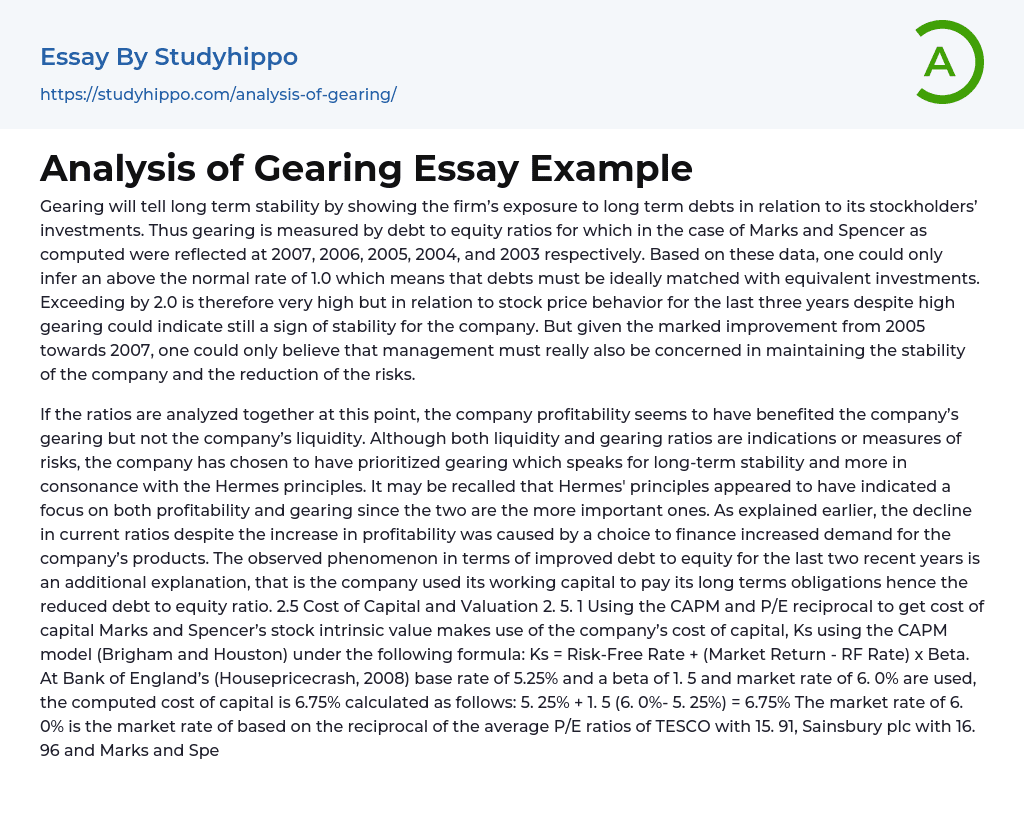The long-term stability of Marks and Spencer can be evaluated by examining its gearing, which is the ratio of long-term debts to stockholders' investments. The company's gearing was calculated for 2007, 2006, 2005, 2004, and 2003. The data shows that the gearing value exceeded the typical rate of 1.0, indicating a preference for matching debts with investments. A gearing value above 2.0 is considered exceptionally high. However, despite this high level of gearing, the past three years have seen a stable behavior in the company's stock price.
However, considering the significant improvement from 2005 to 2007, it is evident that management is committed to maintaining the company's stability and reducing risks. When analyzing the ratios together, it can be observed that the company's profitability has benefited its gearing, but not its liquidity. Both liquidity and gearing ratios are in
...dications of risk, but the company has made a priority of gearing, which aligns with the Hermes principles and emphasizes long-term stability. The Hermes principles emphasize the importance of profitability and gearing. As previously explained, the decrease in current ratios, despite increased profitability, was a result of the decision to finance higher demand for the company's products.
The company's lower debt to equity ratio in the past two years can be attributed to using its working capital to pay off long-term obligations, thus improving its financial position.
When evaluating the cost of capital and valuation for Marks and Spencer's stock, the CAPM model (Brigham and Houston) is employed. This includes determining the company's cost of capital, Ks, through the formula: Ks = Risk-Free Rate + (Market Return - RF Rate) x Beta. Furthermore, the reciprocal of the P/E ratio is
utilized in this calculation.
According to Bank of England's (Housepricecrash, 2008) base rate of 5.25% and using a beta of 1.5 and market rate of 6.0%, the cost of capital is computed to be 6.75%. This calculation is done by adding 5.25% (base rate) and 1 (beta).
5 (6. 0%- 5. 25%) = 6.75%
The market rate of 6. 0% is determined by the reciprocal of the average P/E ratios of TESCO with 15. 91 and Sainsbury plc with 16.
The P/E ratios for 96 and Marks and Spencer are 17 and 33 respectively. The average of these ratios, when reciprocated, equals 6%. Similarly, the reciprocal of the P/E ratio for Marks and Spencer is also 6%. This rate is almost identical to the market rate with a slight variation in decimal points. Notably, the cost of capital is also 6%.
The calculated cost of capital for Marks and Spencer, using the reciprocal of its latest P/E ratio as 6%, is approximately 75% as computed under CAPM. This paper restricts the calculation to companies within the retail industry that have easily accessible information. The beta value of 1.5 is sourced from Telegraph.co.
UK (2008). The market rates of the selected industries have little variability, which suggests that the computed rates truly represent the average. Intrinsic value under constant growth model is compared to the quoted stock price outside Valuation. The constant growth model assumes a dividend per share growth rate of 5% per year, despite the actual average growth rate of 15%. It also uses a discount rate of Ks of 6.
The formula for computing 75% is P0 = D1 / (KS - g). The current rate is not functional as
it would result in a negative divisor and thus a negative stock price. This limitation should be recognized in the model. Using P0 = D1 / (KS - g), P0 represents the price per share. D1, the estimated dividend for the next year, is derived from the dividend last year, D0, multiplied by (1 + 5% assumed).
It is important to mention that the model can only be applied if the constant growth rate of dividends is lower than the cost of capital.
- Asset essays
- Depreciation essays
- Discounted Cash Flow essays
- Foreign Direct Investment essays
- Funds essays
- Internal Rate Of Return essays
- Revenue essays
- Day Trading essays
- Futures Trading essays
- Capital market essays
- Million essays
- Payment essays
- Rate Of Return essays
- Funding essays
- Hedge Fund essays
- Electronics essays
- Computer Science essays
- Consumer Electronics essays
- Enterprise Technology essays
- Hardware essays
- Robot essays
- engineering essays
- people search essays
- Modern Technology essays
- Impact of Technology essays
- Cloud Computing essays
- Operating Systems essays
- Information Technology essays
- Data Analysis essays
- Information Age essays
- Smartphone essays
- Cell Phones essays
- Camera essays
- Computer essays
- Ipod essays
- Mobile Phones essays
- 3g essays
- Bluetooth essays
- Cell Phones in School essays
- Computer File essays
- Desktop Computer essays
- Servers essays
- Data collection essays
- Graphic Design essays
- Data Mining essays
- Cryptography essays
- Internet essays
- Network Security essays
- Android essays
- Computer Security essays




